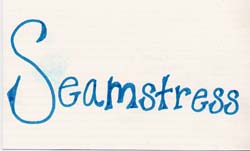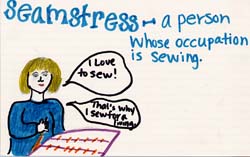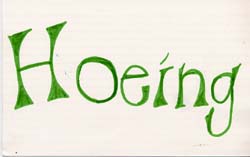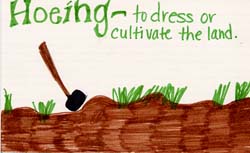
Summary:
This book is about a slave girl who is seperated from her mother and
sent to work on another plantation due to lack of help. While working
at the Home Plantation, Clara is taken in and cared for by Aunt Rachel
another slave on the plantation. Coming to the conclusion that Clara
was too weak to work in the fields, Aunt Rachel teaches Clara how to sew
so that she could come and work with her in the Big House. While
working in the Big House, Clara begins to hear many discussions of the
Underground Railroad and becomes curious. Maps were hard to keep
up with on the journey of the Underground Railroad, especially when it
rained. Knowing this Clara sets out to make a map out of a quilt
using the information from those who care to share with her. When
the quilt is finished, Clara and Jack set off to find Clara's mother and
they escape to freedom.
Discussion Director
Your job is to develop questions group members will discuss about this
portion of the book; decide important ideas and issues raised in this section
of the book and design questions that address them.
Examples: Setting, Problem-Solving, Narrator, Topic, Main Idea,
Cause-Effect, Mood, Character Relationship, and Compare/Contrast
You will want to begin questions with words like:
Who, What, Where, When, Why, How, Tell, Describe
Character - MCEOG:
1. Aunt Rachel taught Clara how to -
A. Weave
B. Gather Cotton
C. Sew
D. Wash Clothes
(Page 3, paragraph 3 - C. Sew)
Genre:
2. What genre is this book? How do you know?
(This book is Historical fiction and I know this
because it is a story about slavery, which took place during
the Civil War, but it is not a true story.
The events could have taken place, but we have no proof that these
characters actually existed.
Setting:
3. Where did Clara go after being taken from the North Farm?
(Page 1, Paragraph 1 - Clara was taken to Home
Plantation because they needed another field hand.)
Problem/Solution:
4. The slaves were having problems keeping a map because it would wash
away in the rain. How did Clara solve this
problem?
(Page 13, Paragraph 3 - She decided to make a map out
of a quilt.)
Cause/Effect:
5. Why did Clara have problems sewing at first?
(Page 3, Paragraph 3 - Clara had a hard time sewing
because her hands were rough and clumsy from hoeing and
weeding the fields.)
Passage Picker
Your job is to select significant passages from the sections being
read; determine why it is important; call other readers’ attention to the
passage and lead a discussion on it.
Steps:
1. Pick
out a passage you would like to share.
2. Write
down the page and paragraph number.
3. Write
down the first two words and the last two words of your passage.
4. Write
down the reason you chose the passage, and explain why!
5. Ask
a question about your passage, and give an answer.
6. Write
down the Author’s Purpose: To Describe, To Entertain, To Inform,
or To Persuade.
1. Passage One – Dialect
2. Page 3, Par. 2
3. “Sweet Clara…an idea.”
4. I chose this passage because it gives readers
an example the Slaves Dialect during this time frame in the South.
5. Q: What is Aunt Rachel’s idea?
A: She is going to teach
Clara how to sew, so that she will be able to work in the Big House
with her.
6. Author’s Purpose: To Describe
1. Passage Two – Descriptive
2. Page 5, Par. 4
3. “Next morning…knotted up.
4. I chose this passage because through the author’s
words you can imagine how nervous Clara
really was.
5. Q: Why was Clara’s stomach in knots?
A: Because the only white
person she had ever seen up close was the overseer and if the
Missus liked her work; white people in the Big House would surround her.
6. Author’s Purpose: To Describe
1. Passage Three – Descriptive
2. Page 7, Par. 1
3. “The morning…my hand.”
4. I chose this passage because the author’s words
allow you to get a vivid picture of what the
sewing room would look
like if you were there.
5. Q: What was Clara given in the sewing room?
A: Aunt Rachel gave Clara
some sheets to hem.
6. Author’s Purpose: To Describe
1. Passage Four – Historical
2. Page 10, Par. 3
3. “There been…the paterollers.”
4. I chose this passage because its Historical reference
about how the slaves ran away to the North to be free, and how
the paterollers went in search of them
when they escaped.
5. Q: Who were the ideal candidates to join
the paterollers?
A: The masters in the county.
6. Author’s Purpose: To give Historical Context.
Character Sketcher
Your job is to develop a character map of major characters in the text.
You will find three words that describe the character. For each word,
or character trait, you will give the proof, or example. The next
thing you will do is to tell one of your character’s goals, or what the
character wants to do in that chapter(s). Then you will find one
of the character’s problems in that chapter(s) and the solution or possible
solution to the problem. Finally, you get to have fun and illustrate
your character.
Aunt Rachel
Character Traits:
Motherly – (page 3, par. 1) Even though Clara was not related by blood,
she took Clara in
and raised her like one of her own.
Patient:
(page 3, par. 3) Because she did not give up on Clara when she was learning
how
to sew. Aunt Rachel saw that learning to sew was not easy for Clara,
so she took it real slow.
Teacher
– (page 12, par. 2) Because she teaches Clara about the Underground Railroad
and the meaning behind it.
Goal: To Get Clara out of the fields and into the Big House working with her.
Problem: Clara cannot sew.
Solution: Teach Clara to
sew well, so that she can become a seamstress in the Big House.

Word Wizard
Your job is to search the section of text for words that are key to
understanding what is happening in the story; notes on the page and sentence
where found; check the dictionary meaning of the word from context and
what the word contributes to the importance of the passage. On your
recording sheet, first write the word and the page number. Then,
write one of the following:
Definition
The sentence using the word
Your own sentence using the word
1. Plantation (page 1, par. 1)
2. “Before I was even twelve years old, I got sent
from North Farm to Home Plantation ‘cause
they needed another field
hand.”
3. Plantation – An agricultural estate usually worked
by resident labor.
4. Plantation – A large farm that houses the workers
that takes care of it.
5. Noun
6. Why was Clara sent from North Farm to Home Plantation?
Because they needed another
field hand.
1. Seamstress (page 3, par. 7)
2. “Why I got to make the stitches so tiny?”
I complained. “You gon’ be a real seamstress,
that’s why.”
3. Seamstress – a woman whose occupation is sewing.
4. Seamstress – Someone, usually a woman who sews
well or makes their living by sewing.
5. Noun
6. My grandmother is a seamstress; she sews quilts.
7. Word Wizard Card


1. Overseer (page 5, par. 4)
2. “I never been inside the Big House before or seen
white people that close – ’cept the
overseer.”
3. Overseer – Supervisor; one who supervises.
4. Overseer – One who is in charge.
5. Noun
6. The Principal is the overseer of my school.
1. Hoeing (page3, par. 3)
2. “It wasn’t easy for me to learn, my hands already
rough and clumsy from hoeing and weeding
the fields.”
3. Hoeing – to dress or cultivate the land.
4. Hoeing – removing weeds from the land.
5. Verb
6. Before we could plant the flowers in the garden,
we had to finish hoeing.
7. Word Wizard Card


Investigator
Your job is to dig up background information on the Underground Railroad.
The information you find will help your group understand the book better.
Ways to gather information:
2. What are some positives and negatives for
escaping in the summer and winter?
Summer:
(Positives) You wouldn’t have to worry about the cold. The trees
were green, and there were lots of berries
and small animals
for food. (Negatives) It was always easier for hunters to follow
you. It could be too hot. It could be
difficult to
cross rivers.
Winter:
(Positives) The rivers were frozen so you could cross them by walking on
the ice. There were less bounty
hunters looking
for fugitives. The slaves usually ran away on Christmas time when
their masters would be at parties.
(Negatives)
It was cold. There was not enough clothing. There was not enough
food or animals to hunt.
3. What were some of the terms
and code words associated with the
Underground
Railroad?
Heaven
or Promise Land – Canada
Drinking
Gourd – Big Dipper and the North Star
Station
– Place of safety and temporary refuge, safe house
Preachers
– Leaders, speakers of the Underground Railroad